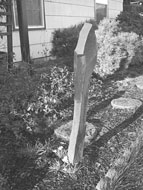 Stone is evidently the solid foundation on which Allen Hopper has built his metaphorical home. His very nature seems unyielding in his love for his wife, Crystal; his dog, Sadie and his passion for finding beauty inside some of the hardest rock on the planet. As one enters his home in Gresham, Oregon, evidence of his passion stands frozen in striking shapes that were mostly formed by nature with some encouragement from his talented hands. He gave us a tour of his amazingly clean and organized studio, hardly a rock chip or speck of dust anywhere, and with short notice. We found his front and back yard lined with dozens of his favorite pieces he has collected over time.
Stone is evidently the solid foundation on which Allen Hopper has built his metaphorical home. His very nature seems unyielding in his love for his wife, Crystal; his dog, Sadie and his passion for finding beauty inside some of the hardest rock on the planet. As one enters his home in Gresham, Oregon, evidence of his passion stands frozen in striking shapes that were mostly formed by nature with some encouragement from his talented hands. He gave us a tour of his amazingly clean and organized studio, hardly a rock chip or speck of dust anywhere, and with short notice. We found his front and back yard lined with dozens of his favorite pieces he has collected over time.
Allen invited us to view and photograph a few of his most recent pieces and those he has waiting to be worked. The task of moving them into position for capturing their best side took two of us. Allen does not work small. We chatted for a good portion of one morning simply about rocks. The average person couldn’t fill two sentences about rocks. Allen can turn this otherwise dull topic into something fascinating. He spoke about how the various rocks came to be: the formation of the earth, the physics behind the different hardnesses and how the various elements form to make different kinds of rock. He doesn’t just know how to make something look nice, he brings a romance to the art by explaining the origin of the stone and the story behind how he came to possess each one that he has.
DH: What is your favorite stone that you work with?
AH: I haven’t decided which is my favorite stone. I have been working mostly with basalt, as that is what the local stone yards have in the sizes I need to work with. It’s amazing the varied shapes, textures, and inclusions that can come from that one kind of stone. W’re lucky to live in an area where we have an abundance of basalt. If I lived in Tennessee, I’d be working with limestone. I do have some limestone that I picked up, some stair tread remnants. I’m excited about getting into them.
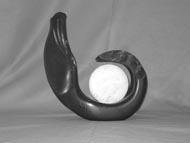
DH: What is your earliest memory of working with stone or looking for rock?
AH: In the early eighties, when I was 10, our folks took us four kids on a trip around the United States, yes, all six of us in one car! We went north along Canada down through the Dakotas, through to Mexico and back to Oregon. It took three months. Luckily, we traveled in a big Chevy Suburban, towing an eighteen-foot travel trailer. Everywhere we went we were picking up rocks. I’ve always been interested in the geology of the rock formations on the side of the road. Everywhere I go I’m always looking at the cliffs. I’m interested in what the rocks are and how they got there. I like to think about the flow that happened at that time, the way it cooled and the shapes that it left behind.
DH: Tell me about the first time you took one of the rocks you found and made some sort of shape from it. What kind of tools did you use? What inspired you to make something from that stone?
AH: My wife and I bought a house and needed to fill it with art. We couldn’t find anything that really excited us. So, I decided I’d make something. In eastern Oregon I picked up a chunk of basalt column and started making phone calls about how I could get the face of it polished. My search lead me to Stuart Jacobson of McMinnville, Oregon, who allowed me to work in his shop and help him with some of the stone he was working on in exchange for teaching me how to polish a stone. That sent me on a path from which I haven’t been able to deviate. From that first stone, where I simply polished the face, to getting involved with NWSSA, and learning from so many other sculptors, I’m now able to transform a block of stone into something aesthetically pleasing. I can’t bring myself to stop doing it.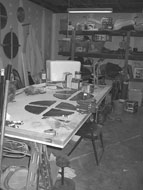
DH: What sort of tools do you use when you are working with stone?
AH: Mostly angle grinders. I like working with angle grinders because of the gyroscopic action. I’ve learned to control that force and apply it to making interesting shapes in stone. That is why I work in the larger realm. I can’t do miniatures or table size pieces because I just don’t have the tools to make smaller items. I work with angle grinders in my trade of concrete and masonry restoration, so I was accustomed to them. It wasn’t a big transition to get into a water-fed angle grinder. It allows me to expand on my creativity with the stone, achieving more in less time, and without the dust. Plus, I make my own tools that work with the grinders. For instance, I’ve created a tool by welding a ¼” piece of steel into a t-configuration. I put a bevel on the end. Attaching the grinder to the end and adjusting each pass a quarter of an inch allows me to control the distance of each straight line cut. That allows me to make angled cross hatch, checkering, or parallel patterns on the stone. I’ve applied what I learned, from decorating gun handles and rifle stocks, to working in stone.
I’ve been exposed to the application of many types of epoxies. I use them extensively in my trade. I know what works with each kind of stone. I know how to glue stones together creating a mosaic of two or more kinds of stone. This adds interest through varying textures and colors. I can take a stone that has a crack the size of a human hair and fix the crack before I even start on the stone to avoid breakage. I work with tools that pump these epoxies into the stone to improve the chance that it will not break when I’m working with it.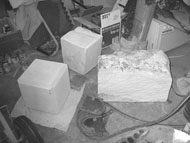
I’ve acquired a die grinder and looking at various pneumatic tools and chisels. I’ve found some difficulty in applying them to the harder stone, but having them will allow me to work various types of softer stone.
DH: Since you work mostly with larger stone, what are the types you have worked with?
AH: I’ve worked mainly with basalt. I bought my first retail stone just before the 2004 symposium in Silver Falls. It was a piece of red marble, 20”x 30.” I bought a piece of pyrophylite from the stone vendor at the Silver Falls Symposium. I’ve found a few vendors around the Portland, Oregon area that carry the stone I can work.
DH: How do you manipulate or move the large stone around?
AH: I’ve got a sore back. Until now, I’ve just been moving them around by hand with, perhaps, the help of someone else. I’m finding that this allows me to work with sizes only up to about 300 lbs. I’m going to get an engine hoist or cherry picker. That should allow me to move a stone up to 4,000 lbs. That way I can get about a three foot lift and save my back.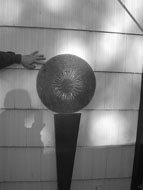
DH: Of the pieces you have made, have you kept them for your own enjoyment, given them away as gifts or sold them?
AH: I have given away some as presents. I’m curently being shown at Blackwell Brothers Fine Arts Gallery in McMinnville, Oregon. I’ve had some sales in my first year there. They’ve been very receptive and supportive of my work.
DH: What role has NWSSA played on your new journey in this artistic realm of stone?
AH: I wouldn’t be creating art now without the Northwest Stone Sculptors Association. I would have produced the first polished faced stone with Stuart Jacobson and been happy with it. Now I go to art galleries as often as I can. I try to find art in everything I see. If it’s junk, I look for what I can make out of it. If it is a remnant, I look to see what I can form from it. I’ve found inspiration in odd places. After being at a show where there is sculpture, it really fires me up. I have to go work on a stone to get that energy out. After the Silver Falls Symposium, I was really eager to get back and finish the stone I had started on. I look forward to working with those who have had years more experience, to learn from them, and to encourage those that are new to stone sculpting by helping them in any way I can. I know I wouldn’t have achieved what I have as a new sculptor without the support of NWSSA.
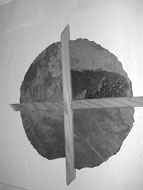
DH: Where do you draw your inspiration from while working with stone?
AH: I look at the stone and either a stone talks to me or it doesn’t. I’m not now able to take a flat block of stone and pull an image from it. If I stumble across a rough, raw stone, I know instantly what needs to be pulled out and it’s just a matter of getting that image out. I’ve bought several cubical blocks of stone and they are just sitting around, mocking me. I tried with one stone to force something out and had to stop in the middle of it. It is still sitting, unfinished, where I left it. I’m told, by the stone, what to do. It’s either in there or it’s not.
DH: How many pieces of raw stone do you have sitting around your house calling for your attention?
AH: Right now, about six or seven that are waiting to be worked on, and thirty or forty that I don’t see anything in yet.
DH: What kind of new tools do you hope to learn to use in the next year?
AH: I’m looking for a big 14” cut-off saw, something that will help me get to the heart of the stone faster. With a 4” angle grinder, it takes several passes, kerfing and chipping to get into where the sculpture is. Even for flat-cut bases, it’s nice to have a larger saw. A pneumatic chisel is in my sights. I had the chance to use one on basalt and it didn’t work out well. I’m getting into softer stone now, so that will help a lot.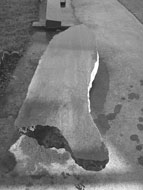
DH: For centuries, people have used stone in various aspects of art and architecture to enhance their lives. How has stone fit into your life and what importance does it have for you?
AH: It didn’t start out as a deep philosophical endeavor for me. I just wanted to take a stone and make something nice out of it. One piece led me to the next. I found myself doing stone sculpture and contemplating what meaning it has had for humanity. It was just by accident that I’ve gotten interested in stone sculpting.
DH: I notice you like working with metal, and wood as well as stone.
AH: I like putting them all together. There is a natural beauty in stone. All of the colors and textures can’t be duplicated. That is why I always leave a natural edge, or area of the stone in the pieces I do. I make crucifixes that are a combination of wood and stone. I can sand, polish and stain the wood to reach a specific luster or reveal the grain. The stone is left natural. So the combination and contrast of the two mediums is quite striking. I’m working on a piece that combines an old oxygen or acetylene gas tank (that I cut in half) with what I think is the rim of an old wheel. I’m going to join those pieces together with stone to make a bell. I now envision making all kinds of mixed pieces using those three elements.